 Have you ever had the discussion about “what makes a craft gin, craft”? For me, there are many factors but I’m also interested in the story and the dedication to the gin. Smeaton’s gin is one of those such gins. They use the “Bristol method” which involves distilling each botanical separately, and each batch of distillates varies in maceration length and temperature of distillation to ensure that the very best flavours are achieved. They base their gin on a recipe from 1870 and use eight botanicals, usual suspects juniper, coriander, orange, orris, angelica and liquorice meet cinnamon and calamus – a plant commonly used to help with stomach ailments. Team Smeaton feel that no garnish is needed for their gin as they invest their time into blended it to the perfect taste so nothing is needed to enhance it. Bold claims, so let’s see how it tastes.
Have you ever had the discussion about “what makes a craft gin, craft”? For me, there are many factors but I’m also interested in the story and the dedication to the gin. Smeaton’s gin is one of those such gins. They use the “Bristol method” which involves distilling each botanical separately, and each batch of distillates varies in maceration length and temperature of distillation to ensure that the very best flavours are achieved. They base their gin on a recipe from 1870 and use eight botanicals, usual suspects juniper, coriander, orange, orris, angelica and liquorice meet cinnamon and calamus – a plant commonly used to help with stomach ailments. Team Smeaton feel that no garnish is needed for their gin as they invest their time into blended it to the perfect taste so nothing is needed to enhance it. Bold claims, so let’s see how it tastes.
brighton girl
Ginvent 2018 – The Teasmith gin
 Day four is upon us and with that comes The Teasmith gin. Founded in Aberdeenshire, their unique botanical is hand picked tea, which they say gives it a minty, sweet finish. The team behind Teasmith wanted to create a gin which celebrated the area they are from, an ethos that seems to link together the new Scottish distilleries. Did you know that James Taylor from Auchenblae (north east Scotland) was the first man to create a tea plantation in Sri Lanka? Seemingly his work there made the island the tea growing paradise that it is now, and the Teasmith team use loose leaf black Ceylon tea from there. All of that history and tradition is bottled in one of the nicest looking bottles on your shelf. But that aside, how does it taste?
Day four is upon us and with that comes The Teasmith gin. Founded in Aberdeenshire, their unique botanical is hand picked tea, which they say gives it a minty, sweet finish. The team behind Teasmith wanted to create a gin which celebrated the area they are from, an ethos that seems to link together the new Scottish distilleries. Did you know that James Taylor from Auchenblae (north east Scotland) was the first man to create a tea plantation in Sri Lanka? Seemingly his work there made the island the tea growing paradise that it is now, and the Teasmith team use loose leaf black Ceylon tea from there. All of that history and tradition is bottled in one of the nicest looking bottles on your shelf. But that aside, how does it taste?
Ginvent 2018 – Manchester Wild Spirit gin
 It’s day two here on the #ginvent blog and today we are drinking Manchester Wild Spirit gin. I’ve tried Manchester gin before but not this version. The Wild Spirit gin is inspired by the woodland walks around Manchester. Taking their signature gin as a base, they remove the orange and lemon and replace these with the deeper, herbal notes from sage, thyme, lemon balm and a hint of woodland with silver birch. Manchester gin is fairly synonymous with dandelion and burdock, and this stays in this edition to give it a warming note midway through before a crisp finish.
It’s day two here on the #ginvent blog and today we are drinking Manchester Wild Spirit gin. I’ve tried Manchester gin before but not this version. The Wild Spirit gin is inspired by the woodland walks around Manchester. Taking their signature gin as a base, they remove the orange and lemon and replace these with the deeper, herbal notes from sage, thyme, lemon balm and a hint of woodland with silver birch. Manchester gin is fairly synonymous with dandelion and burdock, and this stays in this edition to give it a warming note midway through before a crisp finish.
Ginvent 2018 – 58 Clearly Sloe gin
 IT’S DAY ONE OF GINVENT 2018! Here we go again for a third year running. Sorry liver. To kick things off we are trying If you’ve read my blog for the last two years you might have seen my two previous blogs on 58 Gin – their normal gin here and their navy strength here. In those posts you can learn more about 58 Gin, because today we are looking at their sloe gin, and you’d be forgiven for looking past this bottle to try to find the sloe gin. Sloe gins that we know and love are a rich, deep purple colour. This one? Not so much. Rather than seeping sloe berries in a bottle of gin as per the standard method, the berries are included in the distillation process which apparently allows all the flavour, but none of the colour. So, does it actually taste like a sloe gin?
IT’S DAY ONE OF GINVENT 2018! Here we go again for a third year running. Sorry liver. To kick things off we are trying If you’ve read my blog for the last two years you might have seen my two previous blogs on 58 Gin – their normal gin here and their navy strength here. In those posts you can learn more about 58 Gin, because today we are looking at their sloe gin, and you’d be forgiven for looking past this bottle to try to find the sloe gin. Sloe gins that we know and love are a rich, deep purple colour. This one? Not so much. Rather than seeping sloe berries in a bottle of gin as per the standard method, the berries are included in the distillation process which apparently allows all the flavour, but none of the colour. So, does it actually taste like a sloe gin?
Ginvent 2018 – Tarquin’s Tan Ha Mor gin
 Anyone that knows anything about the Gin Foundry calendars knows that Tarquin’s is ingrained into everything they do. One of the first to be involved with Junipalooza, they have also been featured in every Ginvent calendar since the beginning (you can read about their Cornish Dry, Seadog and British Blackberry). This year is no exception and we get to try a brand new and exclusive gin, the Tan Ha Mor. So what makes this gin unique? Working in collaboration with our favourite Gin Foundry folk, they built two firepits on their local beach and smoked English oak chips with coriander, juniper, pink grapefruit and oranges which had previously been smoked in seawater. These were then left to macerate in their Seadog gin before being bottled at 50.5% ABV – the co-ordinates of the beach they roasted the botanicals on.
Anyone that knows anything about the Gin Foundry calendars knows that Tarquin’s is ingrained into everything they do. One of the first to be involved with Junipalooza, they have also been featured in every Ginvent calendar since the beginning (you can read about their Cornish Dry, Seadog and British Blackberry). This year is no exception and we get to try a brand new and exclusive gin, the Tan Ha Mor. So what makes this gin unique? Working in collaboration with our favourite Gin Foundry folk, they built two firepits on their local beach and smoked English oak chips with coriander, juniper, pink grapefruit and oranges which had previously been smoked in seawater. These were then left to macerate in their Seadog gin before being bottled at 50.5% ABV – the co-ordinates of the beach they roasted the botanicals on.
Six Bells Gin
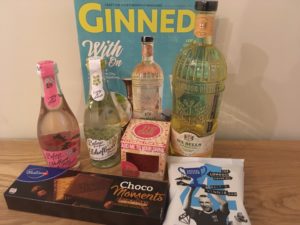 Happy Craft Gin Club delivery! And a big cheers to the first in my new home (spoiler alert: buying a house is stressful and expensive). This month’s delivery is yet another exclusive gin, courtesy of the City of London Distillery (which is about 50 feet from my day job just off of Fleet Street by the terrifying junction that is Ludgate Circus.). Alongside the gin, this month we were treated to two Belvoir pressés, a packet of Bahlsen crunchy hazelnut choco moment biscuits, some salt and vinegar London Crisps and a tub of popaballs. The City of London Distillery is so called because, surprise surprise, it is in the heart of the city; they opened their doors in December 2012 and have since gone from strength to strength, winning awards aplenty and now have five gins to their name (with Six Bells becoming their sixth). The focus of this gin is citrus. The usual gin botanicals of juniper, coriander, angelica root and liquorice root are joined by lemon rind, fresh grapefruit and sweet orange to create a big zesty mouthfeel.
Happy Craft Gin Club delivery! And a big cheers to the first in my new home (spoiler alert: buying a house is stressful and expensive). This month’s delivery is yet another exclusive gin, courtesy of the City of London Distillery (which is about 50 feet from my day job just off of Fleet Street by the terrifying junction that is Ludgate Circus.). Alongside the gin, this month we were treated to two Belvoir pressés, a packet of Bahlsen crunchy hazelnut choco moment biscuits, some salt and vinegar London Crisps and a tub of popaballs. The City of London Distillery is so called because, surprise surprise, it is in the heart of the city; they opened their doors in December 2012 and have since gone from strength to strength, winning awards aplenty and now have five gins to their name (with Six Bells becoming their sixth). The focus of this gin is citrus. The usual gin botanicals of juniper, coriander, angelica root and liquorice root are joined by lemon rind, fresh grapefruit and sweet orange to create a big zesty mouthfeel.
Twelve Keys gin
Note: I met the Twelve Keys team on their launch day at Junipalooza and they kindly gave me their final bottle to put on the blog, but as always, I’ll let you know what I think.
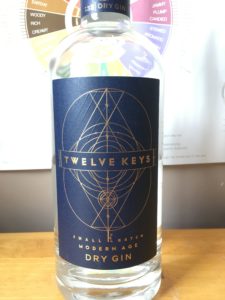 Twelve Keys gin is new. Brand new. I mean they literally launched at Junipalooza on 9 June. They also have a beautiful man in their advertising. But that’s irrelevant (it’s not). Inspired by Basil Valentine – a 15th century alchemist – the twelve botanicals vary from honey (from their own wildflower meadow) to fig, quince, basil and apricot. The fruits are balanced with caraway, frankincense and cinnamon to create a rounder flavour. When I tried this at Junipalooza, they garnished this with a coffee bean and a small piece of fig, and the coffee bean added a depth to the flavour – and I don’t even like coffee!
Twelve Keys gin is new. Brand new. I mean they literally launched at Junipalooza on 9 June. They also have a beautiful man in their advertising. But that’s irrelevant (it’s not). Inspired by Basil Valentine – a 15th century alchemist – the twelve botanicals vary from honey (from their own wildflower meadow) to fig, quince, basil and apricot. The fruits are balanced with caraway, frankincense and cinnamon to create a rounder flavour. When I tried this at Junipalooza, they garnished this with a coffee bean and a small piece of fig, and the coffee bean added a depth to the flavour – and I don’t even like coffee!
Fatty’s Organic Gin
Note: I contacted Fatty’s Organic gin and they kindly sent me a sample to try, but as always, you’ll know if I don’t like it.
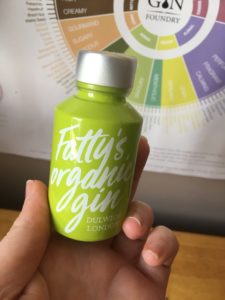 You certainly can’t miss Fatty’s Organic gin on a shelf – the bright green bottle makes sure of that. At the heart of the brand is the need to be organic. Not just slightly organic but 100% organic. In all my drinking time, I’ve only come across one other gin that claims to be 100% organic (although please do correct me if I’m wrong) and I wouldn’t be surprised if this is the next shift for craft gins. Unable to find many options, Fatty (as she is affectionately known) started experimenting in her garden shed. Living in Dulwich, dill became her primary flavour – did you know that Dulwich historically means “the meadow where dill grows”? No, me either. Fatty has worked alongside The Soil Association to ensure everything is done properly, and has been accredited by them.
You certainly can’t miss Fatty’s Organic gin on a shelf – the bright green bottle makes sure of that. At the heart of the brand is the need to be organic. Not just slightly organic but 100% organic. In all my drinking time, I’ve only come across one other gin that claims to be 100% organic (although please do correct me if I’m wrong) and I wouldn’t be surprised if this is the next shift for craft gins. Unable to find many options, Fatty (as she is affectionately known) started experimenting in her garden shed. Living in Dulwich, dill became her primary flavour – did you know that Dulwich historically means “the meadow where dill grows”? No, me either. Fatty has worked alongside The Soil Association to ensure everything is done properly, and has been accredited by them.
Ashmolean Gin
Note: From a previous career, I know one of the co-founders of TOAD gin and when I met them at Junipalooza they kindly gave me a sample to try. As always, I will let you know what I think.
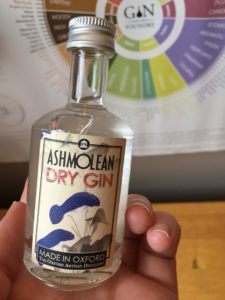 Ashmolean Gin is the product of the collaboration of The Oxford Artisan Distillery and the Ashmolean Museum of art and archaeology. Different to the TOAD gin you might recognise, this gin is inspired by the museum’s collections from around the world and features 17 botanicals including jara lemon, rose, jasmine and spices from the Middle East and Asia. This is complemented by the label illustration taken from Spray of ‘Morning Glory’ by Takeuchi Seiho, a piece you can see if you visit their Eastern Art collection. TOAD are the first distillery to open in Oxford and have an ethos around distilling spirits from grain to glass using heritage grains from a 50 mile radius of their site – all sustainably grown and managed.
Ashmolean Gin is the product of the collaboration of The Oxford Artisan Distillery and the Ashmolean Museum of art and archaeology. Different to the TOAD gin you might recognise, this gin is inspired by the museum’s collections from around the world and features 17 botanicals including jara lemon, rose, jasmine and spices from the Middle East and Asia. This is complemented by the label illustration taken from Spray of ‘Morning Glory’ by Takeuchi Seiho, a piece you can see if you visit their Eastern Art collection. TOAD are the first distillery to open in Oxford and have an ethos around distilling spirits from grain to glass using heritage grains from a 50 mile radius of their site – all sustainably grown and managed.
Lakes Gin – Explorer Edition
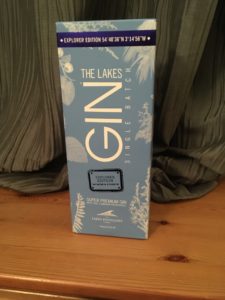 A while ago, Lakes gin kindly sent me a sample of their delicious gin (review of which you can read here). They have a range of spirits in their collection including a whisky and a vodka. My housemate kindly bought home a bottle of their Explorer gin for me to try. This is a special edition gin produced from a single batch distillation using juniper grown in Cumbria and another four botanicals which are native to the Lake District National Park. Their original gin has 10 botanicals in total with an ABV of 43.7% and the Explorer edition bumps this up to 15 botanicals and 47.1% ABV. This gives it a long and aromatic finish with zesty, herbal notes.
A while ago, Lakes gin kindly sent me a sample of their delicious gin (review of which you can read here). They have a range of spirits in their collection including a whisky and a vodka. My housemate kindly bought home a bottle of their Explorer gin for me to try. This is a special edition gin produced from a single batch distillation using juniper grown in Cumbria and another four botanicals which are native to the Lake District National Park. Their original gin has 10 botanicals in total with an ABV of 43.7% and the Explorer edition bumps this up to 15 botanicals and 47.1% ABV. This gives it a long and aromatic finish with zesty, herbal notes.